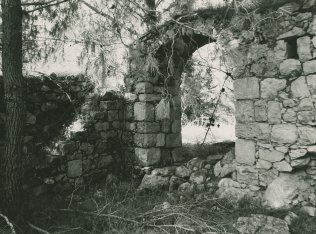| Year | Arab | Total |
|---|---|---|
| 1931 * | 488 | 488 |
| 1944/45 | 40 | 40 |
| Year | Arab | Public | Total |
|---|---|---|---|
| 1944/45 | 5444 | 78 | 5522 |
| Use | Arab | Public | Total | ||||||||||||
|---|---|---|---|---|---|---|---|---|---|---|---|---|---|---|---|
|
4617 | 78 | 4695 (85%) | ||||||||||||
|
827 | 827 (15%) |
The village stood on the lower eastern slope of Mt. Shaykh Ahmad Sulayman and faced south, where it overlooked Wadi Isma'il (a tributary of Wadi al-Sarar). The Jerusalem−Jaffa railway line passed along this wadi. Dirt paths linked 'Aqqur to other villages in the area. In the late nineteenth century, 'Aqqur was a small village built on a ridge and surrounded by very rugged ground. Under the Mandate, it was classified as a hamlet by the Palestine Index Gazetteer and had a small number of (mostly stone-built) houses that were crowded together in a semi-circular plan. The population was Muslim. Village agriculture was rainfed and was based on olives and grain. Olive trees surrounded the village on all sides, especially on the southern side, along Wadi Isma'il. In 1944/45 a total of 653 dunums was planted in cereals; 174 dunums were irrigated or used for orchards, 164 dunums of which were planted with olive trees. The adjacent slopes, covered with wild trees and herbs, were used for grazing and as a source of firewood. The maqam (shrine) and spring of Shaykh Ahmad Sulayman were on the southwestern edge of the village.
Israeli historian Benny Morris writes that the village was taken on 13−14 July 1948, during the second phase of Operation Dani (see Abu al-Fadl, Ramla sub-disctrict). But another Israeli source, the History of the Haganah, states that the village was occupied two months earlier (13 May), during the implementation of Plan Dalet. This information is probably incorrect, since the village is mentioned in connection with a few others which lie some 35 km to the west, near the city of Isdud. Moreover, the New York Times quoted an Egyptian communiqué which stated that 'Aqqur was entered by Egyptian forces just before the first truce, on 10 June. The statement did not say that the village had been seized from Israeli forces.
A thick forest of fir and cypress trees has been planted on the site. Within the forest, stone rubble and the ruins of walls with arched openings and terraces are visible. Cactuses and fig, almond, and olive trees also grow on the site, along with grass and thorns. The forest was established by the Jewish National Fund in memory of Zvai Dubroski, Rose Marcus, and Fami Miliman of Los Angeles, and Sam and Rose Schneider of Detroit.
Related Content
Violence
End of First Truce: Israeli Operations An-Far, Dani and Qedem
1948
8 July 1948 - 17 July 1948

